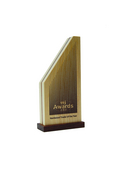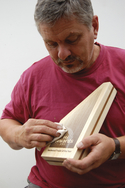Triumphs in tulipwood
13 September 2008An under-appreciated hardwood will take centre stage at this year’s TTJ Awards
David Venables is under no illusions about the popular perception of tulipwood. The straight-talking European director of The American Hardwood Export Council (AHEC) acknowledges that it’s traditionally been seen as the “cheapest and least impressive” US hardwood on the market. So why did AHEC suggest it for this year’s TTJ Awards trophies? Come to that, why did TTJ accept the suggestion?
Before anyone asks, the answer is not credit crunch belt-tightening and, if you doubt our word, head along to London’s South Bank over the next month. That’s where you’ll see the real explanation for our choice – and a truly dramatic expression of it it is too!
Outside the South Bank’s Royal Festival Hall, a main installation of the London Design Festival’s Size+Matter exhibition will be an attention-grabbing public pavilion. Designed by cutting-edge architect David Adjaye, and already featured in the architectural and design press, it will comprise an intricate, interlocking series of timber lattices made up of hundreds of different length 60mm boards, like a giant and very complex children’s puzzle.
The elliptical building will be 12m long by 8.25m wide and 4.5m high. Some parts of the walls and ceiling will be almost solid; others will have gaps for visitors to look through. It will be illuminated so it can stay open night and day and it is expected to have to withstand the tramp of tens of thousands of pairs of feet. It will also be totally unshielded and have to cope with the worst the autumn elements can throw at it. The building’s life won’t be over when the month-long exhibition finishes on October 16 either. At the close of the event it will be dismantled, auctioned by Phillips de Pury and re-erected somewhere else in the UK, or possibly abroad.
Something different
To meet the demands of such an intricate structure and tolerate the wear, tear and weather, you might have thought Mr Adjaye would have opted for something known for exterior durability and use in this kind of high design project; oak maybe, Douglas fir or glulam, or perhaps not even timber at all. But he wanted to try something different, a material he hadn’t used before, with its own unique technical and environmental story. He chose American tulipwood.
As was the case for the TTJ Awards, AHEC actively pushed tulipwood for the pavilion. It was partly down to the fact that the underwhelming market perception of the species had always rankled. Tulipwood, as one of the most prolific American hardwoods (which, of course, also boosts its sustainability credentials) can be a very cost-effective solution. But it also has under-appreciated technical properties. It machines well and has a very good strength to weight ratio. It never really needed to be limited to use as a painted moulding or furniture frame material. On top of that, tulipwood is one of the targets in AHEC’s strategy to provide concrete evidence of the technical capabilities of US hardwoods, especially of under-utilised varieties and, where necessary, to help adapt and improve their inherent characteristics to meet the needs of the modern end user.
“Today our focus is increasingly the product,” said Mr Venables. “We can say to specifiers and end users, this species or that colour is ‘in’, or this timber’s been used in a prize-winning architectural project in Italy, and their response is ‘fine, but we also want to see how it performs. Show us it works – show us the product’.
“Commissioning designer Philip Koomen to make red oak furniture for the Hay-on-Wye literary festival this year was a prime example of our approach. The pavilion is an even more dramatic and, some might say, higher risk one. It’s very high profile and really pushes the boundaries.”
Research
AHEC’s product and performance-centred promotion entails working ever more closely with research bodies and the timber industry. The tulipwood project is a case in point.
“We’ve put it through structural and strength testing at the BRE and their data is now out there,” said Mr Venables. “This shows it has tensile strength characteristics comparable to oak and remarkable strength to weight. In fact, considering its density, the engineers at Hess Wohnwerk in Germany, which is fabricating the pavilion, were amazed by it.”
AHEC has also been working with Osmose to evaluate tulipwood’s potential to take treatment for exterior applications. “It’s proved very absorbent of both water-based and organic solvent products,” said Mr Venables. “Osmose is now working with us to develop whole load treatment schedules and these should be ready in the autumn.”
For the future AHEC sees this sort of technical collaboration becoming even more important. “There’s no doubt that pressures on supplies of tropical hardwoods are set to increase, so we have to make even more of such species as tulipwood,” said Mr Venables. “For exterior applications, you could use treated softwood, or engineered wood, but treated tulipwood gives you the performance and ticks so many other boxes.”
One man who clearly doesn’t need persuading about tulipwood’s potential is Ray Winder, the artist, furniture maker and sculptor who has made the TTJ Awards trophies for the past five years. Proof of this is the 1.5m-long sculpture he made in the timber which hangs on the staircase wall in his house. For AHEC he also previously made a 1m diameter, hollowed-out sphere, built up from layers of laminated tulipwood boards.
Variation
“Some people are put off by the variation in grain and colour you can get in the species – and I’ve seen some with purple and green streaks in it!” he said. “But others like that and, equally, you can select out the most common colour, which is a light golden yellow.”
The timber, he said, also “machines up very nicely”. “If it is available pressure treated, I think it would be particularly good for windows,” he said. “You get a very smooth, clean finish and it’s very stable.”
For the trophies this year, Mr Winder used 1in boards, planed to thickness, with a disk sander used to trim and square off the edges. A layer of American black walnut is bonded between and the bases are in the same dark timber to give a contrast to the clear, honey colour and light grain of the tulipwood.
“I also wanted to give the trophies a hi-tech theme this year,” said Mr Winder. “I was inspired by artist Bridget Riley’s optical designs and wanted to create a similar visual ‘buzz’. So we developed a pattern on the computer comprising a series of elongated triangles with the TTJ Awards logo superimposed. This has been etched into the wood by laser – tulipwood gives you a very crisp, clear finish with lasering – and I then packed walnut filler into the cut areas. It looks a complete mess when the filler first goes in, but it’s very satisfying when you sand it down again and the pattern and lettering emerges.”
Oil finish
Once the names of the Award winners were lasered on, the trophies were given a fine hand sanding and then a natural oil finish. “The oil gives the wood a lovely, warm sheen, and really brings to life the grain and the contrast of the tulipwood against the walnut,” said Mr Winder.
When the trophies were finished, he added, he was moving on to his next tulipwood project, which brings us full circle. The commission from AHEC was for a 15th-sized scale replica of the Adjaye Pavilion which it will display at exhibitions and presentations.
“It will be about 800mm long and use between 300-400 4mm thick pieces of wood in varying widths,” said Mr Winder.
He acknowledged that the complex structure would be a challenge, but he also seemed confident that both he and the tulipwood would rise to it.




